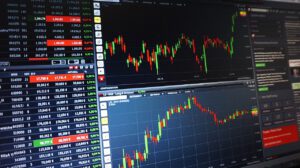By Anna Peel. Originally published at ValueWalk.

The top U.S. securities regulator on Wednesday proposed rule changes to transform how Wall Street handles retail stock trades, but what does this mean for the market and retail traders?
Adam Nasli, head analyst at international broker comparison site BrokerChooser shared his thoughts on the SEC’s plan to overhaul the US market structure and how this can affect retail trading:
Q1 2022 hedge fund letters, conferences and more
“On Wednesday, Gary Gensler unveiled SEC plans to revamp the structure of the US equities market. Some of the key issues highlighted by Gensler are the uneven playing field among players, instances of conflict of interest, and the lack of transparency.
Some of the most important measures implied by Gensler would affect the payment for order flow (PFOF) model, the execution of orders, and pricing of venues.
-
How Would The Changes Affect Retail Trading
Currently, brokers route most retail orders to off-exchange venues (see Table 1. below), to market makers such as Citadel or Virtu. If harmonized tick sizes and order-by-order competition were to be introduced and the national best bid-offer (NBBO) were updated, the race between on-exchange (public exchanges like NYSE) and off-exchange (wholesalers, like Citadel or Virtu) venues would become a lot tighter and a larger chunk of the order flow would likely go to public exchanges.
Based on BrokerChooser’s analysis, major wholesalers (Citadel, Virtu, G1X and Two Sigma) provided $6.1 billion in price improvements in 2020 and 2021 combined. The price improvement means the price between the executed price and the NBBO. The expected impact of the new regulatory change is that steeper competition would result in additional price improvement.
The changes would also significantly affect the business model of brokers, especially the ones that rely heavily on PFOF revenue. In 2021, 77% of Robinhood’s total revenue came from PFOF, while this number was only 11% in case of Charles Schwab-TD Ameritrade. Merrill Edge or Fidelity are among brokers that don’t earn PFOF revenue from stock trading (only from options due to the specific market structure in that segment). Keeping the zero commission business model for brokers that rely heavily on PFOF revenue will be an uphill battle.
-
A Closer Look At The Payment For Order Flow
Many US brokers, including household names like Robinhood or TD Ameritrade, provide commission-free trading for US customers and earn their revenue from the PFOF model. PFOF is a practice where brokers are compensated by market makers, like Citadel or Virtu, for selling customer order flows. Based on BrokerChooser’s analysis, the following brokers earned the most from PFOF in 2020-2021:
Table 1.
| Broker name | PFOF earned from stocks and options
(in USD million) |
Execution venue % of S&P 500 stocks’ non-directed orders* | Number of clients as of 2022 Q1 end
(in million) |
| 1. TD Ameritrade | $994 | Off-exchange: 98%
On-exchange: 0% |
33.6** |
| 2. Robinhood | $532 | Off-exchange: 100%
On-exchange: 0% |
22.8 |
| 3. E*TRADE | $316 | Off-exchange: 92%
On-exchange: 8% |
7.6 |
| 4. Charles Schwab | $222 | Off-exchange: 99%
On-exchange: 1% |
33.6** |
| 5. Webull | $118 | Off-exchange: 95%
On-exchange: 1% |
NA |
*Non-directed orders are the orders when the customer doesn’t specify the execution venue. Most brokers route these orders to market makers. Percentages may not add up to 100% in some cases because the data covers only non-directed orders, i.e. when customers don’t specify the execution venue.
**Charles Scwhab and TD Ameritrade merged in 2021.
Customers should be aware that commission-free trading does not equal zero costs. US brokers that rely on PFOF offer less price improvement to their customers. Here, at BrokerChooser, we consider this missed price improvement as an implicit cost because customers would usually be better off if they chose a broker that doesn’t rely on PFOF (e.g. Fidelity or Merrill Edge) over a broker that relies on it (e.g. Robinhood or TD Ameritrade).
The overhaul of the market structure, resulting in fiercer competition between off and on-exchange venues, as well as potential changes affecting the conflict of interest inherent in the PFOF model would highly affect brokers that pocket significant amounts from this revenue stream.
-
Suggested Changes To Even The Playing Field Between Off-Exchange And On-Exchange Venues
On-exchange venues, like NYSE, can price assets at one penny increments while off-exchange venues offer sub-penny pricing. The SEC plans to harmonize tick sizes between on and off exchange venues. This is a change that Kenneth Griffin, founder and CEO of Citadel (one of the biggest market markers) also suggested during the GameStop hearing last year.
Another important change would be the introduction of open and transparent auctions for orders to enhance the order-by-order competition. The order-by-order competition means that retail orders would interact directly with institutional orders, which is currently not the case as most retail orders are executed at off-exchange venues, while institutional orders are mostly executed at on-exchange venues.
Lastly, the SEC plans to improve the calculation of the NBBO reference price. For example, odd lots (orders less than 100 shares) are not included in the NBBO. This would be a great change and the new NBBO would better reflect market conditions as most retail customers likely submit odd lots.
In light of the above, the SEC anticipates that competition will intensify and retail traders will have access to better prices.”
Updated on
Sign up for ValueWalk’s free newsletter here.



